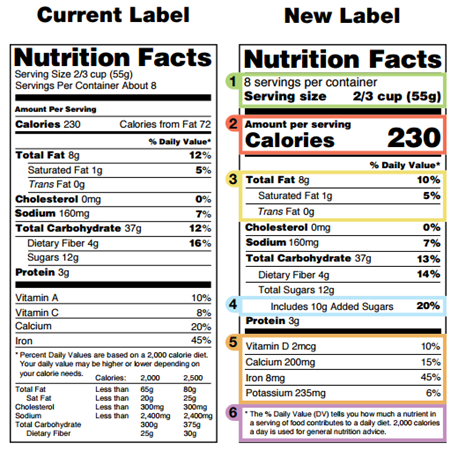Co
ntinued from the PART II, today we co
ntinue to introduce Nutrition Facts label and Other requirements for food labeling in the US.
11. Nutrition Facts label
The US nutrition facts label has a history of more than 20 years. In order to ensure that co
nsumers can obtain the latest and most accurate nutrition facts of food, the new FDA regulation 81 FR 33741 has established the latest nutrition facts label format for prepackaged food. Manufacturers with more than $10 million in annual food sales were required to switch to the new label by January 1, 2020; manufacturers with less than $10 million in annual food sales can keep old label until January 1, 2021 to comply. Figure 1 is a comparison of the old and new nutrition facts labels in the United States.
Fig. 1 Comparison of old and new Nutrition Facts labels in the United States
11.1 General order for listing statutorily declared nutrients and other mandatory or voluntary nutrients on the Nutrition Facts label
Calories, Calories from Saturated Fat*, Total Fat, Saturated Fat, TransFat, Polyunsaturated Fat*, Mo
nounsaturated Fat*, Cholesterol, Sodium, Fluoride*, Total Carbohydrate, Dietary Fiber, Soluble Fiber*, Insoluble Fiber*, Total Sugars, Added Sugars, Sugar Alcohol*, Protein, Vitamin D, Calcium, Iron, Potassium
*If the nutrient is claimed, it must be labelled; otherwise, the nutrient can be labelled voluntarily.
11.2 Order for listing voluntary vitamins and minerals on the Nutrition Facts label
Vitamin A, Vitamin C, Vitamin E, Vitamin K, Thiamin, Riboflavin, Niacin, Vitamin B6, Folate, Vitamin B12, Biotin, Pantothenic Acid, Phosphorus, Iodine, Magnesium, Zinc, Selenium, Copper, Manganese, Chromium, Molybdenum, Chloride, Choline
11.3 Position on a label
Nutrition Facts label shall be declared as the principal display panel together with the list of ingredients, name and address of the manufacturer, packer, or distributor. These three items can also be displayed on the information page. If there is no place to display on the principal display panel and the information page, the nutrition facts label shall bear a declaration of any side visible to consumers.
12. Other requirements
Other parts of the label may include date, batch, storage conditions, directions for use, warnings, universal product code (UPC), etc., as long as the overall label is not misleading.
12.1 Date of Production
The U.S. federal regulations require a "Use-By" date on infant formula, other products are not required. In China, the production date and shelf life of prepackaged food should be clearly indicated in the food label.
12.2 Batch and Directions for use
Low-acid canned foods and acidified foods in the US need to indicate batches, and infant formula foods shall indicate directions for use.
Recommend article:
How Much Do You Know about Food Labeling in the US?(PART I)
How Much Do You Know about Food Labeling in the US?(PART II)
[Origin] Overview of Food Labeling Requirements for Export to the US
Please note: Original English article of Business Division of Food Safety and Regulatory Compliance of Global Foodmate, please indicate the source from the Global Foodmate if reprint.
Business Division of Food Safety and Regulatory Compliance of Global Foodmate provides food standards & regulations research, labelling compliance consulting/Chinese label design, industry public opinion monitoring and analysis, registration services (of Infant formula, FSMP, Health food, Novel Food Ingredients, Novel Food Additives, New Varieties of Food-Related Products and Overseas manufacturers of imported food) and other comprehensive food safety solutions for domestic and overseas enterprises and institutions in food industry.
Please feel free to contact us: +86 10 68869850, E-mail: global_info@foodmate.net


